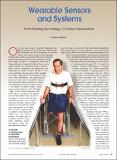| dc.contributor.author | Bonato, Paolo | |
| dc.date.accessioned | 2012-03-30T15:57:53Z | |
| dc.date.available | 2012-03-30T15:57:53Z | |
| dc.date.issued | 2010-05 | |
| dc.identifier.issn | 0739-5175 | |
| dc.identifier.other | INSPEC Accession Number: 11290113 | |
| dc.identifier.uri | http://hdl.handle.net/1721.1/69890 | |
| dc.description.abstract | It is now more than 50 years since the time when clinical monitoring of individuals in the home and community settings was first envisioned. Until recently, technologies to enable such vision were lacking. However, wearable sensors and systems developed over the past decade have provided the tools to finally implement and deploy technology with the capabilities required by researchers in the field of patients' home monitoring. As discussed, potential applications of these technologies include the early diagnosis of diseases such as congestive heart failure, the prevention of chronic conditions such as diabetes, improved clinical management of neurodegenerative conditions such as Parkinson's disease, and the ability to promptly respond to emergency situations such as seizures in patients with epilepsy and cardiac arrest in subjects undergoing cardiovascular monitoring. Current research efforts are now focused on the development of more complex systems for home monitoring of individuals with a variety of preclinical and clinical conditions. Recent research on the clinical assessment of wearable technology promises to deliver methodologies that are expected to lead to clinical adoption within the next five to ten years. In particular, combining home robots and wearable technology is likely to be a key step toward achieving the goal of effectively monitoring patients in the home. These efforts to merge home robots and wearable technology are expected to enable a new generation of complex systems with the ability to monitor subjects' status, facilitate the administration of interventions, and provide an invaluable tool to respond to emergency situations. | en_US |
| dc.language.iso | en_US | |
| dc.publisher | Institute of Electrical and Electronics Engineers (IEEE) | en_US |
| dc.relation.isversionof | http://dx.doi.org/10.1109/MEMB.2010.936554 | en_US |
| dc.rights | Article is made available in accordance with the publisher's policy and may be subject to US copyright law. Please refer to the publisher's site for terms of use. | en_US |
| dc.source | IEEE | en_US |
| dc.title | Wearable Sensors and Systems | en_US |
| dc.type | Article | en_US |
| dc.identifier.citation | Bonato, Paolo. “Wearable Sensors and Systems.” IEEE Engineering in Medicine and Biology Magazine 29.3 (2010): 25–36. Web. 30 Mar. 2012. © 2010 Institute of Electrical and Electronics Engineers | en_US |
| dc.contributor.department | Harvard University--MIT Division of Health Sciences and Technology | en_US |
| dc.contributor.approver | Bonato, Paolo | |
| dc.contributor.mitauthor | Bonato, Paolo | |
| dc.relation.journal | IEEE Engineering in Medicine and Biology Magazine | en_US |
| dc.eprint.version | Final published version | en_US |
| dc.identifier.pmid | 20659855 | |
| dc.type.uri | http://purl.org/eprint/type/JournalArticle | en_US |
| eprint.status | http://purl.org/eprint/status/PeerReviewed | en_US |
| dspace.orderedauthors | Bonato, Paolo | en |
| mit.license | PUBLISHER_POLICY | en_US |
| mit.metadata.status | Complete | |
